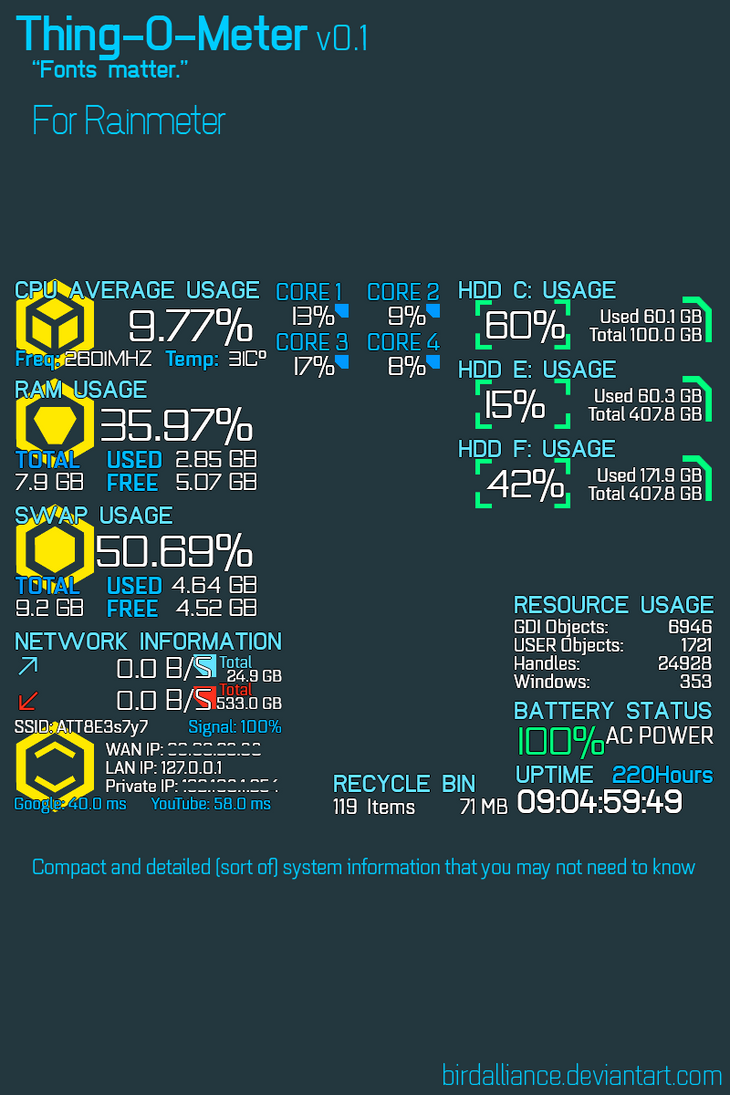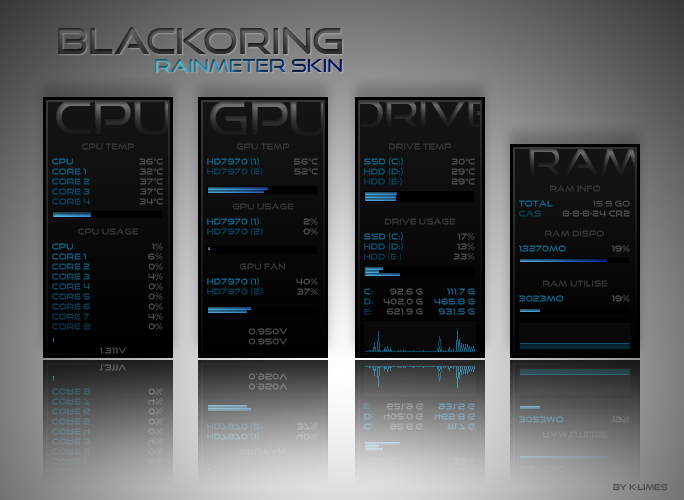Tech-A is a system monitoring Rainmeter Skin and Suite designed to make give your complete control of your system resources, launcher, and functions. It has a unique design that presents the information on your desktop in a logical and tech style. The dark theme and glowing blue light make the theme come alive.
- Rainmeter Skins Windows 10
- Rainmeter Skin Packager Download
- Rainmeter System Temperature Skins
- Best Rainmeter System Monitor Skins
- Rainmeter Skins Free Download
- Iron Man Rainmeter Skin Download
- Best Rainmeter Themes
This Rainmeter Skin is best used as a system monitoring suite with other add-ons and plugins. The composition of the suite include the following:
A simple and clean system monitoring skin for Rainmeter. Music spotify cpu dashboard rainmeter skins rainmeter-skin Updated Jul 5, 2020; SourcePawn; Jack-Myth.
This rainmeter skins showcases all your system details and your desktop in a newspaper’s format. It looks really nice! You must try this at least once! Newspaper Desktop Rainmeter weathers Skins showcases many details like calendar, the temperature of your locality, news story columns, date and time, usage of CPU and RAM, weather. This is a Start Menu replacement for Rainmeter. It has metro/win8 and classic/win7 style options and comes in two sizes, small and standard. It also features an update checker to inform you of the latest Rainmeter (configurable to check for betas or finals) or Start Menu skin updates. For more info see the forum page. Rainmeter Skins uses very little hardware resources and will run perfectly well on any PC using Microsoft Windows 7 through Windows 10. This rainmeter skins is a bit similar to the design of Razor. It follows the same translucent frames, but an improvised version of it. Speed Rainmeter Skin looks amazing when paired with a god background. Unlike the sharp edgy shapes of the Razor’s skin, this skin has some smooth and curve surfaces which makes it look simple and tidy.
- 1 to 6 CPU’s
- 0 to 6 Drives
- Upload and download
- Ram
- Buttons
- Shortcuts and
- Weather (Vclouds modified)
The beauty of this Rainmeter skin is the constant support provided by the Author, most challenges you may encounter have been addressed. You can check the comment section to read more on how to resolve any situation you may be finding difficult to overcome.
The Tech-A Skin for Rainmeter theme enjoys over 150 downloads daily and has been downloaded over 570,000 times, this supports the fact that it is popular and the theme works. The file size is quite heavier than most Rainmeter Skins.
Tweaking or modifying this theme is not easy a good knowledge of Rainmeter is required before you can make progress. Some modifications have appeared, however, this remains the most consistent and better option.
Tech – A Skin for Rainmeter
File Size: 11.8MB
Author: Burnwell88
Related
Rainmeter's basic purpose is to run skins. A skin is a movable, dynamic, sometimes-interactive window that appears over the Windows desktop, and usually gathers and displays information of some kind.
Rainmeter Skins Windows 10
Skins come with many different sizes, styles, user interfaces, and levels of complexity. Rainmeter includes utilities for publishing and installing 3rd-party skins. Each skin is generally stored and loaded as an independent, self-contained module.
Files and Folders
Rainmeter Skin Packager Download
All skins are stored in Rainmeter's 'Skins' folder. If Rainmeter has been installed normally, the default location of the Skins folder is:
C:UsersYourNameDocumentsRainmeterSkins

If Rainmeter is installed as a portable application, the Skins folder is found in the installation folder. The Skins folder can also be changed in Rainmeter's settings.
A skin is stored as a named .ini text file e.g. SkinName.ini in its own named folder within Skins, as in: RainmeterSkinsSkinFolderSkinName.ini.
Enhanced acoustic simulator for engineers. All of these folder paths may be referenced in a skin as built-in-variables.
Variants
If a single folder contains multiple SkinName1.ini, SkinName2.ini ..etc. files, they are each considered variants of the same skin. Only one variant can be active at a time, and all variants use the same settings. Separate skins not to be treated as variants must be stored in separate folders.
Variants:C:UsersYourNameDocumentsRainmeterSkinsillustroClock12HrClock.iniC:UsersYourNameDocumentsRainmeterSkinsillustroClock24HrClock.ini
Separate skins:C:UsersYourNameDocumentsRainmeterSkinsillustro12HrClockClock.iniC:UsersYourNameDocumentsRainmeterSkinsillustro24HrClockClock.ini
@Resources
Rainmeter System Temperature Skins
Any supporting files used by the skin, such as images, addon executables, sounds, or Lua scripts, should also be stored in the skin folder. Complex skins are recommended to store supporting files in a folder called @Resources inside the root config folder. The @Resources folder is used by Rainmeter to load custom fonts and custom cursors.
Config
Each skin is identified with a certain config name. The config name is based on the path from the main Skins folder to the skin file. For example, if a skin is located at..
C:UsersYourNameDocumentsRainmeterSkinsillustroClockClock.ini
..then the config name would be:
illustroClock
Because skins may have any number of variants, many Rainmeter features, especially bangs, refer to a specific skin by its config name, rather than the skin's filename.

Root config
Skins may also be stored in subfolders within the same root config folder. They share the same @Resources folder, and are packaged and installed together. Otherwise, Rainmeter treats each subfolder as a separate config.
For example, the following skins belong to the 'illustro' suite:
C:UsersYourNameDocumentsRainmeterSkinsillustroClockClock.iniC:UsersYourNameDocumentsRainmeterSkinsillustroNetworkNetwork.ini
This means that they are both located in the same root config folder, 'illustro,' in the main Skins directory.
C:UsersYourNameDocumentsRainmeterSkinsillustro
The root config folder for a skin will ALWAYS be directly under C:UsersYourNameDocumentsRainmeterSkins. No matter how many levels of folders your suite of skins may have, there will always be a single, shared root config folder for that suite of skins, directly under the .Skins folder. This is where the @Resources folder must be.
Each skin has a unique config name:
illustroClockillustroNetwork
But since they belong to the same root config, they share the same @Resources folder: Webcam toy camera app.

Best Rainmeter System Monitor Skins
C:UsersYourNameDocumentsRainmeterSkinsillustro@Resources
A suite is an informal term for skins that are organized together in this manner. Suites are often used by skin authors to make a set of skins that share a common style, or complement each other in some way. If a root config folder contains only one SkinName.ini file, then the config and root config are the same, and the skin can be stored, packaged and installed by itself.
Rainmeter Skins Free Download
Format
The SkinName.ini file is written as a standard INI file, which uses the following format:
Each property of the skin is defined by a section. Each key is an option that modifies that property. The following sections may be used in skins:

[Rainmeter]
Defines options that affect the entire skin.[Variables]
Defines text strings that can be used throughout the skin.Measures
Objects that retrieve (or 'measure') information of some kind.Meters
Objects that display information and other visual elements.MeterStyles
Define options that may be used by several meters.[Metadata]
Defines the name, version, license, and other non-functional information about the skin.
A skin must have at least one meter. All other properties are optional, and may not even be present, depending on what is needed for the skin. For skins that are publicly distributed, the [Metadata] section is strongly recommended.
There are only a few rules about using the INI format:
- All section names in a skin must be unique.
- All option names within a section must be unique.
- Section and option names should include alphanumeric characters only (no spaces or punctuation).
- Option values must be kept on a single line.
'Quotes' are not needed around strings used as an option value. Rainmeter will ignore quotes around option values.
Update
When a skin is loaded, it updates on a regular cycle. The length of time between updates is defined by the Update option in the [Rainmeter] section, and defaults to 1 second (or 1000 milliseconds). The update determines when the skin reacts to changes in the values of variables, measures and options.
Individual meters and measures can be made to update more slowly by 'skipping' cycles, using the UpdateDivider option. In addition, the !Update bang forces the skin to update immediately, resetting the timed cycle.
Iron Man Rainmeter Skin Download
Refresh
When a skin refreshes, all values are reset, and the skin starts over as if it had just been loaded for the first time. Refreshing also applies any changes that have been made to the code in SkinName.ini.
Best Rainmeter Themes
A skin can be refreshed from the context menus, or using the !Refresh bang.